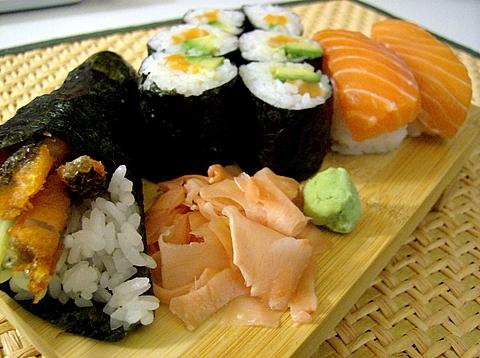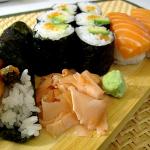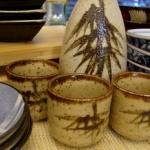A Roll-Your-Own Sushi Party
Party Preparations
Japanese Green Tea
4 cups hot water, just under boiling temperature
5 tbsp green tea leaves
Place the loose tea leaves into a teapot. Add hot water. Steep for 3 to 5 minutes. Pour into cha-wan mugs and serve hot. Serves 4.
Miso Soup
The base for miso soup is a stock called dashi. To make dashi, you will need:
One quart of water
One 4" piece of dried konbu (dried sea kelp)
One cup of katsuo (dried bonito shavings)
Rinse or wipe the dusty coating from the surface of the konbu and place in a pot with one quart of water and cook over high heat. When the water comes to a boil remove and discard the konbu. Add the katsuo and bring to a boil again. Remove the pan from the heat and allow it to cool. Strain the liquid into a separate container and discard the katsuo. The remaining liquid is called dashi and can be used as a base to make a wide variety of soups and dipping sauces.
To prepare Miso Soup you will need:
1 quart of dashi
4 tbsp miso paste
1 tbsp dried wakame seaweed flakes, finely chopped
1 cup of tofu cut into ½" cubes
Bring the dashi to a boil in a large saucepan. Add the miso paste and stir with a wooden spoon until it dissolves completely. Bring the mixture just to a boil again and remove from the heat. Add the tofu cubes and wakame. Allow to stand for 5 minutes before serving. Ladle the soup into small bowls, stirring as you ladle to making sure that the miso, tofu cubes and wakame are well distributed between the portions. Serves 4.
Sunomono
The word sunomono means 'vinegared things' and can be prepared with almost any combination of ingredients, from fresh raw vegetables and greens to finely diced seafoods. Here's a tasty and easy to prepare sunomono recipe:
1 Large cucumber
1 cup precooked bay shrimp
Rice wine vinegar dressing
Pickled ginger
Sesame seeds
Wash a large cucumber and trim off the ends. Slice the cucumber in half lengthwise and scrape out the seeds with a teaspoon. Cut the cucumber halves into paper-thin slices and place in a bowl. Add one cup of tiny pre-cooked bay shrimp and marinate for 2 hours (stirring occasionally) in Rice Wine Vinegar Dressing:
1 cup Rice Wine Vinegar
½ cup mirin or sake
2 teaspoon sesame oil
Thoroughly mix and serve the sunomono in small individual dishes with a slotted spoon to drain off excess marinade. Garnish with a pinch of pickled ginger and sprinkle with sesame seeds. Serves 4.
Sushi Rice
3 cups dry white sushi-grade rice
3 cups water
1/3 cup rice wine vinegar
2 tbsp sugar
1 tsp salt
Cook the rice in an automatic rice steamer, or use the stovetop instructions on the package. When the rice is done, dissolve the sugar and salt in the rice wine vinegar in a small pan over low heat. Sprinkle the vinegar mixture into the cooked rice and fluff gently with a wooden rice paddle to mix.
Place the cooked rice in a large wooden bowl or spread on a baking sheet to cool. Fan the rice with a pleated fan or piece of stiff paper for 8 to 10 minutes, tossing and stirring every few minutes. This will produce an attractive sheen and helps keep the rice sticky. When the rice is cool to the touch, you can begin using it to make sushi. Serves 4 (about 1 1/2 cups cooked rice per person). Do not refrigerate sushi rice. Instead, prepare it up to two hours ahead and cover with a damp dish towel until serving time.
Preparing the Fresh Ingredients
Fish - Fish for nigiri sushi should be cut into uniform slices from the best part of the filet. Each slice should be cut across the grain, about 1 inch wide by 2 inches long, and no more than 1/4 inch thick. For makizushi, the fish may be cut into smaller pieces, or you can use the trim from the filet.
Salmon Skin - Trim the skin away from the fish, leaving a thick rind of fish on the skin. Slice the salmon skin into 1/2 inch strips and fry in hot oil until crispy and lightly browned. Drain on paper towels.
Shrimp - Shrimp for nigiri sushi should be peeled, with the tail intact, and skewered with a bamboo skewer to keep it from curling. Steam for about 2 minutes, until just pink and tender, allow to cool, remove from the skewer and butterfly to lay flat. For makizushi, the shrimp should be completely cleaned and peeled, and steamed until just pink and tender. Once it is cool, the shrimp may be chopped or left whole.
Other Seafood - Seafood ingredients such as crab, imitation crab, eel, oysters, scallops, and fish roe may be used as is. However, depending upon their size, and the type of sushi they will be used to make, certain items may need to be sliced or chopped.
Vegetables - Depending on the type of sushi roll, cucumbers should be cut into thin julienne strips about 4 inches long for hand rolls, or into thick spears about 6 inches long for kappa maki. Avocados should be peeled and cut into thin wedges. Daikon radish should be shredded into fine ribbons with a mandolin.
Snacks
Sembei - Any well-stocked gourmet grocery or Asian market, especially one that specializes in Japanese foods, will carry a variety of sembei snacks. These crunchy little rice crackers and tidbits are usually seasoned with soy sauce, some are wrapped in nori, and all are delicious. However, beware that many contain MSG, so read the labels if you're sensitive or allergic. Sembei make an excellent starter for you and your guests to munch on while finishing up with the preparations. They are especially tasty with a nice, cold Japanese beer.
Edamame - These tasty young soybean pods are most commonly available in the frozen vegetable section of some supermarkets and many Asian grocery stores. To prepare, follow the cooking instructions on the package.
If you are fortunate enough to find them fresh at a produce market in the late summer months, or you are able to grow your own, remove the fresh pods from the beanstalk, wash them thoroughly and drop them in boiling water for about five minutes, or until tender. When they're done, remove them from the water, drain them and sprinkle lightly with coarse salt if you like. Allow them to cool and serve them in the pods.
Edamame can also be prepared in the microwave. Place 2 cups of soybean pods in a microwave-safe dish, cover and cook on full power for 4 or 5 minutes. Sprinkle lightly with coarse salt, allow them to cool and serve in their pods.
Setting the Table for a Roll-Your-Own Sushi Party
Rolling sushi requires more space than your average place setting. Therefore, your party table should provide plenty of room for plates full of raw ingredients, and all the extra utensils and serving dishes. Each place setting should include a sushi plate or wooden geta for serving finished sushi, a dipping dish for soy sauce, a dish of ginger and wasabi, a bowl for miso soup, a dish for sunomono appetizers, a fingerbowl filled with water, a pair of chopsticks, a napkin, and glassware for tea, beer and sake. Utensils for each guest should include a bamboo rolling mat covered with plastic wrap, a very sharp knife, and a hand towel.
Communal ingredients for the table should include bowls of snacks such as sembei and edamame, a large bowl of sushi rice, plates of prepared seafood and vegetables, a stack of seaweed wrappers, a bottle of soy sauce, Shared utensils for the table should include a nigiri sushi mold, and a cutting board.If you have more than four guests, and your table is large, or long, you may wish to double up on utensils and plates of ingredients, so that each guest has easy access and doesn't have to wait for a single ingredient or utensil to make its way around the table.
How to Roll Your Own Sushi
Assorted Nigiri
¼ pound fresh sushi-grade tuna
¼ pound fresh sushi-grade hamachi or snapper
¼ pound salmon
3 cups sushi rice
1 tablespoon wasabi paste
Pickled ginger
Soy sauce
With a very sharp knife, cut the fish into uniform 1"x2" slices about ¼" thick. If desired, rub a pinch of wasabi paste down the center of each slice.
Dip your hands in rice vinegar or warm water, and with your left hand, scoop up enough sushi rice to fill the center of your palm. With the index and middle fingers of your right hand, press and shape the sushi rice into a tight oblong ball. (You can also use a sushi rice mold which can be purchased in Asian markets and kitchen supply stores.)
Lay a slice of fish across the rice ball and place the sushi on an attractive serving dish. Repeat the process with the remaining fish and rice. Garnish with a mound of pickled ginger, a ball of wasabi paste and serve with soy sauce for dipping. (Makes about 40 pieces)
Makizushi
2 cups sushi rice (see recipe)
4 oz fresh tuna, sliced into 1/2" strips
4 sheets of nori seaweed wrapper
1 teaspoon wasabi paste
Lay a 12x12" sheet plastic of wrap on a flat dry surface, such as a cutting board or countertop. Place a bamboo sushi rolling mat on it and fold up the edges to completely cover the mat. Lay a sheet of nori on the plastic-covered bamboo mat. Dip your fingers into a bowl of water, scoop up about 1/4 cup of sushi rice and cover the lower half of the nori with a thin layer, pressing firmly and distributing rice evenly all the way out to the left and right edges.
With your right thumb, rub a pinch of wasabi paste on the nori across the top edge of the rice.
Lay several strips of tuna, end-to-end, across the center of the rice.
Moisten the upper edge of the nori with a few drops of water.
Starting at the bottom edge, begin firmly but gently rolling the bamboo mat and nori, cigar style, around the strips of tuna until the rice surrounds the center. Lay the bamboo mat flat and continue rolling the nori to the moistened upper edge.
Fold the bamboo mat upward around the sushi roll and squeeze firmly along the length of the roll to compact the filling and seal the moistened edge of the nori.
Remove the bamboo mat and cut the sushi roll in half, and then each half into thirds to form 6 uniform pieces. Repeat the process with the remaining ingredients.
Stand each set of sushi rolls upright on an attractive serving dish and garnish with a ball of wasabi paste and a mound of pickled ginger.
For variety, you can also substitute strips of fresh cucumber, salmon, shrimp, crab, avocado, or a combination of these ingredients. (makes 24 pieces)
Salmon Skin Temaki (Hand Rolls)
1 cup sushi rice
16 crispy salmon skin strips
1/4 cucumber, thinly julienned
1 teaspoon wasabi paste
2 nori wrappers, cut in half
Place the half nori wrapper across the palm of your left hand. Place about 1/4 cup of sushi rice at a slight angle at the left edge. Rub a pinch of wasabi paste across the nori at the edge of the rice. Place 4 strips of salmon skin and a few strips of cucumber on top of the rice. Moisten the right edge of the nori with water and roll the nori into a cone around the filling. Seal the cone at the moistened edge. Makes 4 rolls.
 ThingsAsian
ThingsAsian



















